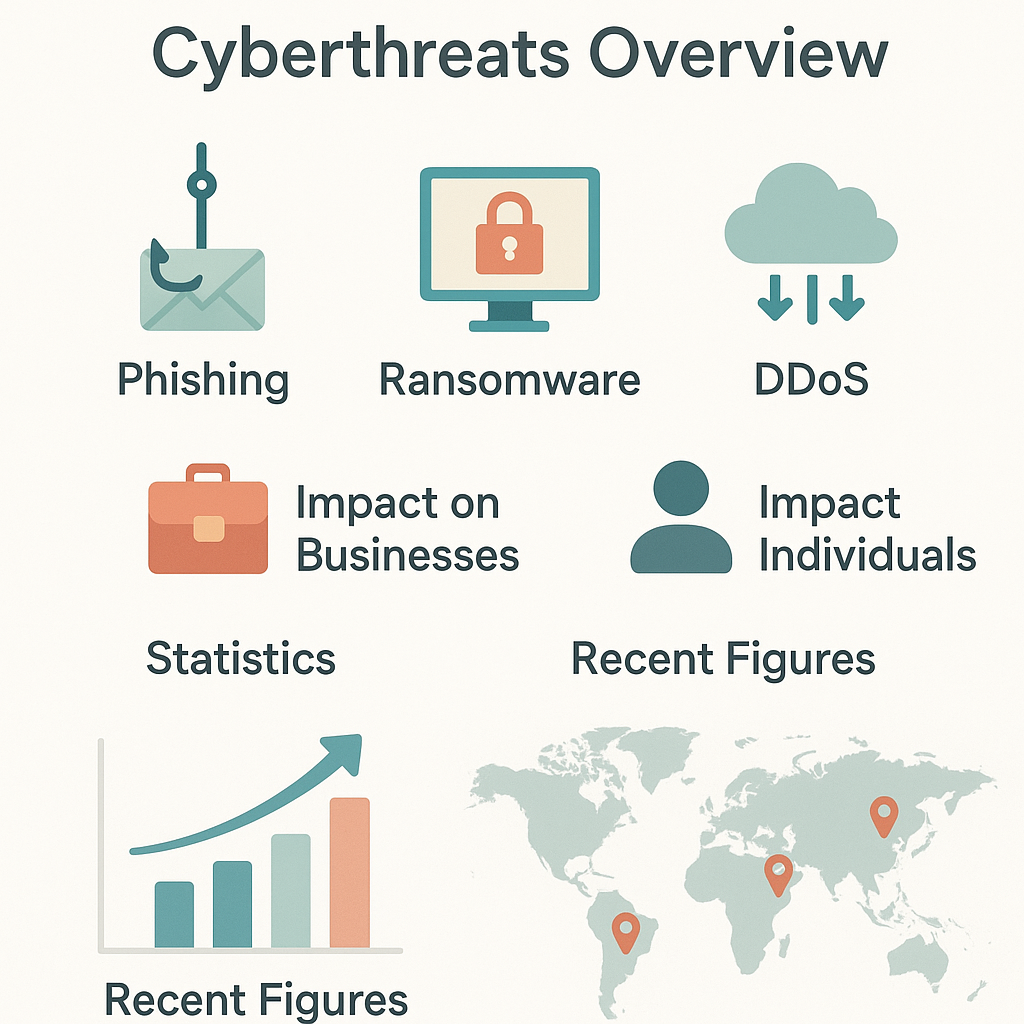Cyberthreats pose increasing risks to businesses and individuals worldwide, with attacks growing more sophisticated and costly each year. From phishing and ransomware to DDoS attacks, these digital dangers can devastate operations and compromise sensitive data. Understanding effective prevention strategies is crucial for maintaining robust security in our interconnected digital landscape.
Good to know
Human error accounts for approximately 95% of successful cyber attacks, making employee training and awareness programs one of the most effective defenses against cyberthreats. Regular security training can reduce phishing success rates by up to 70%.
Understanding cyberthreats and their impact
Cyberthreats represent malicious activities designed to damage, disrupt, or gain unauthorized access to computer systems, networks, and data. These digital dangers have evolved from simple viruses to sophisticated, multi-vector attacks that target both individuals and organizations with unprecedented precision and scale.
Primary Categories of Cyberthreats
Phishing attacks remain among the most prevalent cyberthreats, involving fraudulent communications that appear to come from reputable sources. These attacks trick victims into revealing sensitive information such as login credentials, financial data, or personal details. According to the FBI’s Internet Crime Complaint Center, phishing incidents increased by 65% in 2024, with losses exceeding $12.5 billion in the United States alone.
Ransomware represents one of the most devastating cyberthreats, encrypting victims’ files and demanding payment for decryption keys. The average ransomware payment reached $1.5 million in 2024, with healthcare organizations facing particularly severe impacts. The Colonial Pipeline attack in 2021 demonstrated how ransomware can disrupt critical infrastructure, causing fuel shortages across the Eastern United States and highlighting the broader economic implications of such attacks.
Distributed Denial of Service (DDoS) attacks overwhelm target systems with traffic, rendering services unavailable to legitimate users. These attacks have grown in sophistication, with the largest recorded DDoS attack in 2024 reaching 3.8 terabits per second, targeting major cloud infrastructure providers.
Economic and Operational Impact
The global cost of cybercrime reached $10.5 trillion annually in 2024, with U.S. businesses bearing approximately 35% of these losses. Small and medium enterprises face particular vulnerability, with 60% of attacked companies going out of business within six months of a significant breach. The average data breach cost in the United States stands at $4.88 million, factoring in business disruption, regulatory fines, and reputation damage.
Beyond financial losses, cyberthreats create lasting operational disruptions. The 2023 MGM Resorts cyberattack paralyzed hotel operations for weeks, while the 2022 Toyota breach exposed personal data of 3.1 million customers, demonstrating how cyber incidents can severely impact customer trust and business continuity across diverse industries.

Securing your network: An integrated approach
Modern network security demands a sophisticated, multilayered approach that goes beyond traditional perimeter defenses. As cyberthreats continue to evolve in complexity and frequency, organizations must implement comprehensive security frameworks that can adapt to emerging risks and protect critical infrastructure from multiple attack vectors.
The Foundation: Next-Generation Firewalls
Next-Generation Firewalls (NGFW) represent the cornerstone of contemporary network security architecture. Unlike traditional firewalls that simply grant or deny access based on predetermined rules, NGFWs integrate multiple security technologies into a single platform. These advanced systems incorporate Application Visibility and Control (AVC), URL filtering, and intrusion prevention capabilities to provide enhanced visibility and control over network traffic.
An NGFW serves as the crucial first step in securing the perimeter by automatically enforcing policies while integrating with additional software solutions. When unknown threats evade standard policies, these integrated tools provide detection and remediation capabilities to protect your network infrastructure effectively.
Integrated Security Technologies
The power of modern network security lies in the integration of complementary technologies. Advanced Malware Protection (AMP) works alongside NGFWs to identify and neutralize sophisticated malware that traditional signature-based systems might miss. Next-Generation Intrusion Prevention Systems (NGIPS) provide superior threat prevention capabilities, particularly in areas such as intrusion detection, vulnerability management, and patch oversight.
These integrated solutions create a comprehensive security ecosystem where each component reinforces the others, ensuring that if one layer is compromised, additional protections remain in place to safeguard critical systems and data.
Strategic Network Segmentation
Smart network segmentation divides your infrastructure so threats can be easily isolated and contained. With the increasing complexity of business applications and user access patterns, identifying network interdependencies has become more challenging. Effective segmentation requires advanced visibility tools to map all network relationships accurately.
The key lies in balanced implementation—overly segmenting the network can slow operations, while insufficient segmentation allows attacks to spread laterally. Organizations must adopt intelligent segmentation strategies that protect critical systems without compromising operational efficiency or user productivity.

Leveraging advanced tools for threat detection and prevention
While network security establishes the foundational defense layer, organizations require sophisticated detection and prevention tools to identify threats that bypass initial security measures. Advanced threat detection technologies provide real-time visibility into potential attacks and enable rapid response to emerging cyberthreats.
Endpoint Detection and Response (EDR) Systems
EDR solutions represent a critical advancement in threat detection, providing comprehensive monitoring of endpoint activities across an organization’s network. These systems continuously analyze behavior patterns, file executions, and network communications to identify suspicious activities that traditional antivirus software might miss. EDR platforms excel at detecting zero-day exploits by monitoring for unusual system behaviors rather than relying solely on signature-based detection methods.
Modern EDR implementations leverage machine learning algorithms to establish baseline behaviors for each endpoint, enabling the detection of anomalous activities that could indicate compromise. When threats are identified, EDR systems provide detailed forensic information, allowing security teams to understand attack vectors and implement appropriate containment measures.
Multi-Factor Authentication and Access Control
MFA, including biometric authentication, serves as a critical barrier against credential-based attacks, requiring users to provide multiple forms of verification before accessing critical systems.Organizations implementing MFA typically see significant reductions in successful account compromises, as attackers cannot easily bypass the additional authentication layers even with stolen passwords.
Token-based authentication systems provide enhanced security for high-privilege accounts and remote access scenarios. Physical security keys offer superior protection compared to SMS-based verification methods, which remain vulnerable to SIM swapping attacks.
VPN and Secure Communications
VPN technology creates encrypted tunnels for online communications, protecting data transmission from interception and manipulation. Organizations must implement enterprise-grade VPN solutions that support advanced encryption protocols and provide centralized management capabilities for remote workforce protection.
AI-Driven Threat Intelligence Services
Third-party threat intelligence services enhance organizational security by providing real-time analysis of global threat patterns and malware signatures. These services aggregate data from multiple sources to identify emerging threats before they impact individual organizations, enabling proactive defense measures against sophisticated attack campaigns.

Building a human firewall: The role of staff training in cybersecurity
While advanced technological solutions form the backbone of cybersecurity infrastructure, the human element remains both the weakest link and the most powerful defense against cyber threats. Employees serve as the first line of defense, making staff training and awareness programs essential components of any comprehensive cybersecurity strategy.
Developing Comprehensive Security Awareness Programs
Effective cybersecurity training programs must go beyond basic awareness sessions to create lasting behavioral change. Businesses should implement structured learning modules that cover the most prevalent attack vectors, including phishing emails, social engineering tactics, and suspicious link identification. These programs should provide employees with practical resources to recognize red flags such as urgent payment requests, unexpected attachments, or emails from unfamiliar senders requesting sensitive information.
Training sessions should incorporate real-world scenarios that employees might encounter in their daily work. For instance, staff should learn to verify suspicious requests through alternative communication channels, such as calling the supposed sender directly. This verification step has proven highly effective in preventing business email compromise attacks that cost organizations millions annually.
Implementing Regular Phishing Simulations
Simulated phishing campaigns serve as powerful tools to assess and improve employee readiness against social engineering attacks. Organizations should conduct these exercises monthly, varying the complexity and style of simulated threats to keep staff alert. Companies that implement regular phishing simulations report significant reductions in successful attack rates, with some achieving click-through rates below 5% after consistent training.
These simulations should be followed by immediate feedback and additional training for employees who fall victim to the test. Rather than punitive measures, organizations should focus on creating learning opportunities that help staff understand why they were targeted and how to better protect themselves and the company in the future.
Fostering a Culture of Security Vigilance
Building an effective human firewall requires cultivating a workplace culture where cybersecurity becomes everyone’s responsibility. Leadership must demonstrate commitment to security practices, and employees should feel empowered to report suspicious activities without fear of blame. This cultural shift transforms staff from potential vulnerabilities into active participants in the organization’s defense strategy, creating multiple layers of human-based threat detection that complement technological security measures.

The essentials to remember about preventing cyberthreats
Preventing cyberthreats requires a comprehensive approach that combines advanced technology, proper network security, and human awareness. As cyber attacks evolve rapidly, organizations must continuously adapt their defense strategies, investing in next-generation tools while fostering a security-conscious culture. The future of cybersecurity lies in proactive threat intelligence, automated response systems, and ongoing employee education to stay ahead of emerging threats.